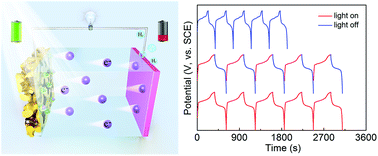Nanoporous Cu@Cu2O hybrid arrays enable photo-assisted supercapacitor with enhanced capacities†
Abstract
Inexhaustible solar energy has been considered as one of the most promising alternatives to traditional fossil energy. The solar energy can be captured by the solar cell, converted into electrical power and then stored in supercapacitors or batteries. Toward higher energy utilization efficiency, how to realize conversion and storage of solar energy in a combined device is becoming increasingly important. Herein, we have designed and fabricated a photo-assisted rechargeable supercapacitor by integrating photo-electrode and working electrode, thereby forming a nanoporous Cu@Cu2O (NPC@Cu2O) hybrid array electrode, which obviously increases the charge capacity. The novel nanoporous/array hybrid structure guarantees light illumination, which improves solar energy utilization efficiency. Moreover, it delivers a specific capacitance of 782 F g−1 at 1 A g−1 under illumination, which increases 37.9% of capacitance than that under dark. Moreover, the capacity increasing mechanism and kinetic analysis revealed that photo-generated holes on the Cu2O surface stimulate more active sites and promote the proton insertion into Cu2O facets. This finding provides a new path to the direct storage of the abundant solar energy.



 Please wait while we load your content...
Please wait while we load your content...